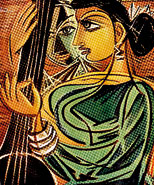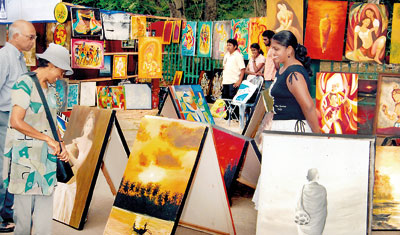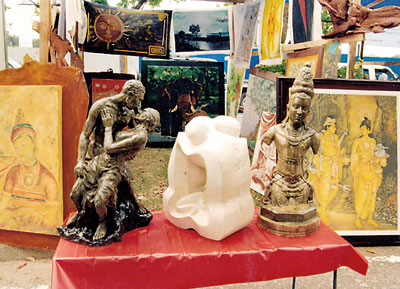The George Keyt Foundation (GKF) will be holding its 17th annual Kala Pola (Art Mart) on Sunday, January 29 on the sidewalks of Lotus Pokuna-Ananda Coomaraswamy Mawatha from 9 a.m. onwards. This year, about 300 artistes have registered to exhibit their work.
British High Commissioner John Rankin, will be the Chief Guest this year following a tradition of Heads of Diplomatic Missions in Colombo often opening the event: in recent years they were, respectively from India, China and the US.
The Kala Pola, is also very much a practical functioning example of the concept of Corporate Social Responsibility (CSR) where the John Keells Group has provided consistent support and sponsorship for the event over the years which has certainly facilitated participation by many young artists without much cost to them.
The Kala Pola is not an exclusivist, elitist “arty” social event. It is not, to use a local expression art for part’s sake. The support and sustenance it has offered young artists, many unknown to begin with, a valuable opportunity to interact with each other, present their work to the public and gain some degree of livelihood support from their talents, is one of the major achievements of the annual event.
George Keyt (1901 – 1993), born, bred and blossomed as a Sri Lankan, has nevertheless had an impact well beyond the island. His personality and his work, knew no constricting borders – ethnic, religious nor cultural. He was of the Dutch Burgher community and was educated at Trinity College, Kandy (TCK). His wife, Ruth, also Burgher, was one of my kindergarten teachers at TCK. Keyt later separated from Ruth and married Pilawela Menike, a Sinhala Buddhist. He later also married Kusum, a Hindu Indian.
In the 1920s, Keyt studied at the Malwatte Vihare in Kandy under the guidance of the poet-scholar Ven. Pinnawelle Dhirananda Thera who guided the artist in Buddhist philosophy. He even contemplated joining the clergy. His paintings at the Gotami Vihare in Borella, depicting the life of the Buddha is eloquent testimony to the inspiration he drew from traditional Sri Lankan Buddhist murals at Gonagala, Mihintale, Mahiyangala and other centres. In the late 1920s , he often contributed to the Buddhist Annual of Ceylon and translated Buddhist scriptures into English.
Keyt’s other early art, described as his “Kandyan Period” had a calm serenity reflecting his early neighbourhood. The figures he drew then were not abstract nor subjected to Cubism as he excelled, for example, in presenting serene naturalist paintings of themes such as Pirith at Malwatte, flower offerings at the Dalada Maligawa, people resting at wayside ambalamas and forest scenes.
An exhibition of his work at the Lionel Wendt Gallery in 1991 celebrating his 90th birthday organized by the George Keyt Foundation with support, inter alia, of the John Keells group, was opened by the then President Ranasinghe Premadasa. In an article to the catalogue I wrote that “art can be a powerful manifestation of a national ethos, however disjointed the times, however fractured the society and however confused the national psyche….Like Ediriweera Sarathchandra, Chitrasena, Amaradeva and Lester James Peiris in other media, Keyt represents an enduring triumph for Sri Lanka and people who value creative expression” without abrasive hostility.
Art critics and scholars, particularly in the West, have described Keyt, inter alia, as a Cubist, given some latter inspiration he did derive from its form and technique. As Keyt matured and widened his sources of inspiration and style, he drew not only from traditional Sri Lankan creative modes, but also from sub-continental forms of art such as the Kangra miniatures and Chola Hindu sculptures. He also merged, as it were, sight and sound, melody and mood from Indian ragas, the Sringara (erotic) traditions, and indeed even (as I once told him to his amusement) Walt Disney in depicting some Yakshas (devils) in the Mara Yuddhaya segment at the Gotami Vihare.
In the 1940s and’50s, Keyt worked on the Nayika (heroine/ beloved) theme. In some paintings, while drawing from Indian art traditions, he incorporated styles and figures from his earlier Kandyan period into a uniquely Sri Lankan mode which is also now very much part of the wider South Asian tradition appreciated globally as well.
Keyt’s poetry, which is not that well known, echoes some of his sensuous Nayika paintings as the following quote from “Darkness Disrobed” illustrates:
“Beneath flowering branches,
You sit relaxed like the twilight
with the blue sky and the yellow sun on
either side of you
Resting your cheek on your arms,
Bare arms like floating waterfalls:
But that which the night will wash away.
I cannot stay sharing your dreams
in the sun”
His first book of poems was published in 1936, the same year that the late Dr. G.P. Malalasekere organized the Ceylon Society of Arts exhibition of works by Keyt and Justin Deraniyagala at the Gallery which borders the Kala Pola displays.
Tim Scott on George Keyt and Picasso
National Trust Lecture
British architect and sculptor Professor Tim Scott will speak on “ George Keyt of Sri Lanka and Picasso of France’ in the 36th lecture in the monthly lecture series of the National Trust of Sri Lanka at the HNB Auditorium, 22nd Floor, HNB Towers, 479 T.B. Jayah Mawatha, Colombo 10 at 6.30 p.m. on Thursday, January 26.
 |
 |
| George Keyt |
Picasso |
Tim Scott is known for his abstract sculptures made from transparent acrylic and steel and more recently ceramics.
His work can be found in many important collections, including the Tate Gallery, London and the Museum of Modern Art, NYC.
The National Trust – Sri Lanka’s monthly lectures are open to the public free of charge.
The events of the National Trust – Sri Lanka are principally sponsored by the HNB Sustainability Foundation. |





